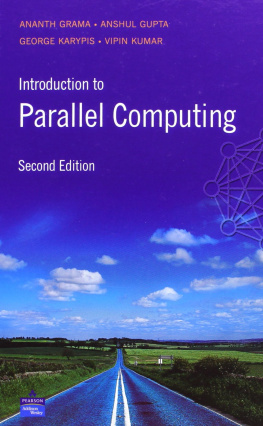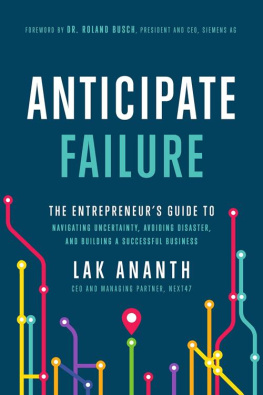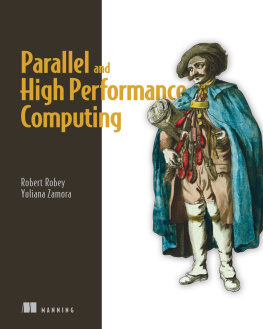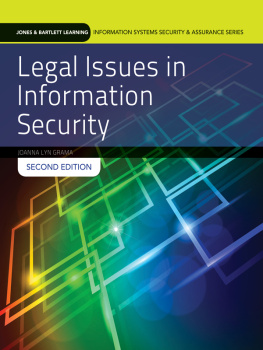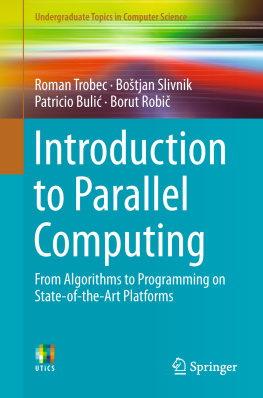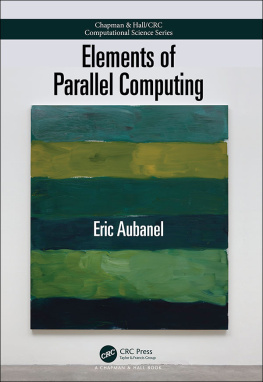Ananth Grama - Introduction to Parallel Computing
Here you can read online Ananth Grama - Introduction to Parallel Computing full text of the book (entire story) in english for free. Download pdf and epub, get meaning, cover and reviews about this ebook. year: 2003, publisher: Addison Wesley, genre: Home and family. Description of the work, (preface) as well as reviews are available. Best literature library LitArk.com created for fans of good reading and offers a wide selection of genres:
Romance novel
Science fiction
Adventure
Detective
Science
History
Home and family
Prose
Art
Politics
Computer
Non-fiction
Religion
Business
Children
Humor
Choose a favorite category and find really read worthwhile books. Enjoy immersion in the world of imagination, feel the emotions of the characters or learn something new for yourself, make an fascinating discovery.
- Book:Introduction to Parallel Computing
- Author:
- Publisher:Addison Wesley
- Genre:
- Year:2003
- Rating:3 / 5
- Favourites:Add to favourites
- Your mark:
- 60
- 1
- 2
- 3
- 4
- 5
Introduction to Parallel Computing: summary, description and annotation
We offer to read an annotation, description, summary or preface (depends on what the author of the book "Introduction to Parallel Computing" wrote himself). If you haven't found the necessary information about the book — write in the comments, we will try to find it.
Introduction to Parallel Computing — read online for free the complete book (whole text) full work
Below is the text of the book, divided by pages. System saving the place of the last page read, allows you to conveniently read the book "Introduction to Parallel Computing" online for free, without having to search again every time where you left off. Put a bookmark, and you can go to the page where you finished reading at any time.
Font size:
Interval:
Bookmark:
| Introduction to Parallel Computing, Second Edition | |
| By Ananth Grama, Anshul Gupta, George Karypis, Vipin Kumar | |
| Publisher | : Addison Wesley |
| Pub Date | : January 16, 2003 |
| ISBN | : 0-201-64865-2 |
| Pages | : 856 |
Increasingly, parallel processing is being seen as the only cost-effective method for the fast solution of computationally large and data-intensive problems. The emergence of inexpensive parallel computers such as commodity desktop multiprocessors and clusters of workstations or PCs has made such parallel methods generally applicable, as have software standards for portable parallel programming. This sets the stage for substantial growth in parallel software.
Data-intensive applications such as transaction processing and information retrieval, data mining and analysis and multimedia services have provided a new challenge for the modern generation of parallel platforms. Emerging areas such as computational biology and nanotechnology have implications for algorithms and systems development, while changes in architectures, programming models and applications have implications for how parallel platforms are made available to users in the form of grid-based services.
This book takes into account these new developments as well as covering the more traditional problems addressed by parallel computers.Where possible it employs an architecture-independent view of the underlying platforms and designs algorithms for an abstract model. Message Passing Interface (MPI), POSIX threads and OpenMP have been selected as programming models and the evolving application mix of parallel computing is reflected in various examples throughout the book.
Copyright Pearson Education Limited Edinburgh Gate Harlow Essex CM20 2JE England and Associated Companies throughout the world Visit us on the World Wide Web at: www.pearsoneduc.com First published by The Benjamin/Cummings Publishing Company, Inc. 1994 Second edition published 2003 The Benjamin/Cummings Publishing Company, Inc. 1994 Pearson Education Limited 2003 The rights of Ananth Grama, Anshul Gupta, George Karypis and Vipin Kumar to be identified as authors of this work have been asserted by them in accordance with the Copyright, Designs and Patents Act 1988. All rights reserved. No part of this publication may be reproduced, stored in a retrieval system, or transmitted in any form or by any means, electronic, mechanical, photocopying, recording or otherwise, without either the prior written permission of the publisher or a licence permitting restricted copying in the United Kingdom issued by the Copyright Licensing Agency Ltd, 90 Tottenham Court Road, London W1T 4LP. The programs in this book have been included for their instructional value. They have been tested with care but are not guaranteed for any particular purpose. The publisher does not offer any warranties or representations nor does it accept any liabilities with respect to the programs. All trademarks used herein are the property of their respective owners. The use of any trademark in this text does not vest in the author or publisher any trademark ownership rights in such trademarks, nor does the use of such trademarks imply any affiliation with or endorsement of this book by such owners. British Library Cataloguing-in-Publication Data A catalogue record for this book is available from the British Library Library of Congress Cataloging-in-Publication Data A catalog record for this book is available from the Library of Congress 10 9 8 7 6 5 4 3 2 1 07 06 05 04 03 Printed and bound in the United States of America Dedication To Joanna, Rinku, Krista, and Renu |
Pearson Education
We work with leading authors to develop the strongest educational materials in computing, bringing cutting-edge thinking and best learning practice to a global market. Under a range of well-known imprints, including Addison-Wesley, we craft high-quality print and electronic publications which help readers to understand and apply their content, whether studying or at work. To find out more about the complete range of our publishing, please visit us on the World Wide Web at: www.pearsoneduc.com |
Preface Since the 1994 release of the text "Introduction to Parallel Computing: Design and Analysis of Algorithms" by the same authors, the field of parallel computing has undergone significant changes. Whereas tightly coupled scalable message-passing platforms were the norm a decade ago, a significant portion of the current generation of platforms consists of inexpensive clusters of workstations, and multiprocessor workstations and servers. Programming models for these platforms have also evolved over this time. Whereas most machines a decade back relied on custom APIs for messaging and loop-based parallelism, current models standardize these APIs across platforms. Message passing libraries such as PVM and MPI, thread libraries such as POSIX threads, and directive based models such as OpenMP are widely accepted as standards, and have been ported to a variety of platforms. With respect to applications, fluid dynamics, structural mechanics, and signal processing formed dominant applications a decade back. These applications continue to challenge the current generation of parallel platforms. However, a variety of new applications have also become important. These include data-intensive applications such as transaction processing and information retrieval, data mining and analysis, and multimedia services. Applications in emerging areas of computational biology and nanotechnology pose tremendous challenges for algorithms and systems development. Changes in architectures, programming models, and applications are also being accompanied by changes in how parallel platforms are made available to the users in the form of grid-based services. This evolution has a profound impact on the process of design, analysis, and implementation of parallel algorithms. Whereas the emphasis of parallel algorithm design a decade back was on precise mapping of tasks to specific topologies such as meshes and hypercubes, current emphasis is on programmability and portability, both from points of view of algorithm design and implementation. To this effect, where possible, this book employs an architecture independent view of the underlying platforms and designs algorithms for an abstract model. With respect to programming models, Message Passing Interface (MPI), POSIX threads, and OpenMP have been selected. The evolving application mix for parallel computing is also reflected in various examples in the book. This book forms the basis for a single concentrated course on parallel computing or a two-part sequence. Some suggestions for such a two-part sequence are:
The material in this book has been tested in Parallel Algorithms and Parallel Computing courses at the University of Minnesota and Purdue University. These courses are taken primarily by graduate students and senior-level undergraduate students in Computer Science. In addition, related courses in Scientific Computation, for which this material has also been tested, are taken by graduate students in science and engineering, who are interested in solving computationally intensive problems. |
Font size:
Interval:
Bookmark:
Similar books «Introduction to Parallel Computing»
Look at similar books to Introduction to Parallel Computing. We have selected literature similar in name and meaning in the hope of providing readers with more options to find new, interesting, not yet read works.
Discussion, reviews of the book Introduction to Parallel Computing and just readers' own opinions. Leave your comments, write what you think about the work, its meaning or the main characters. Specify what exactly you liked and what you didn't like, and why you think so.

